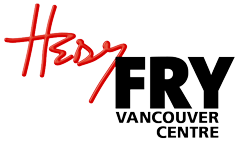December 10, 2018—Hon. Hedy Fry, Vancouver Centre
Mr. Chair, I have been sitting here listening to everyone speak to this issue. I have no doubt that the intent of everyone in this place is one of concern, as some have had personal tragedies, and that we really want to see something done about this.
I am pleased to speak after my colleague from Vancouver East, because I feel like we began with this so many years ago. In 1998, I was the minister responsible for the Downtown Eastside overdose problem; that member was a provincial minister; and the mayor, as she said, was Philip Owen. We were responding at the time to what we in the Downtown Eastside of Vancouver felt was a crisis. There were 417 overdose deaths in one year, which is nothing compared with what we are talking about now. However, in response to that, the three governments came together and signed an agreement called the Vancouver agreement. In that agreement, we committed to working in a non-partisan way to deal with the problem, because we felt that the lives being lost were greater than the partisanship and political spats we always had, for and against.
When we started this, out of the Vancouver agreement came the four-pillar approach to drug use: prevention, treatment, harm reduction and decriminalization. The point was that we agreed and worked hand in hand. Our bureaucrats from all three levels of government sat down regularly every week around a table and talked about what was falling through the cracks, what was being duplicated and how we could move forward. It was a very successful way of dealing with the problem. Here today, we have some provinces and municipalities that do not want to work on this issue. However, working together could move the agenda forward and get things done.
I will relate some facts about this particular problem.
In September 2018, there was a 38% increase in overdose deaths in British Columbia. I am using British Columbia as the national ground zero. Vancouver east was the provincial ground zero, and the national ground zero is now British Columbia, where we have seen a 38% increase in September 2018, representing an 8% increase from August. Ninety percent of those deaths were of people between the ages of 19 to 59, with 72% between the ages of 30 to 59. Therefore, we know the demographic that is at greatest risk.
We know that this is not an urban problem. We are seeing the highest rates now in Thompson Caribou, the northern interior, Okanagan and south Vancouver Island. It is not an urban phenomenon, and we cannot dismiss it as not being in our backyard.
We also cannot limit this problem to the stereotypical addict lying on street, homeless and shooting up drugs. It is now 30-year-olds and family members with young children who are using these substances for whatever reason. Perhaps alcohol is no longer doing it for them, or whatever, but we are seeing young families who should know better, who are educated, utilizing these drugs. We find young people in universities, single young people who have so much potential, overdosing.
I want members to know the truth that this is not a street phenomenon, as 58% of all overdoses have occurred in private residences, 28% in other private places, and only 13% of overdoses have occurred on the streets. Therefore, we are not looking at a phenomenon that some people treat as a moral issue, that we should not care about addicts because, of course, they are throw-away people. I have actually heard that said in the House about addicts. It is a stigma that we parliamentarians have heaped upon addicts, not recognizing this as a health issue. It is something I have fought, and many of my colleagues here have fought that kind of language and stigma.
I note as well that the data indicate that no deaths occurred at supervised injection sites or at drug overdose prevention sites.
What we know is that there are some things that have helped. At those sites, drugs can be analyzed to see if they are tainted with anything or mixed with something. That is a safe thing, because then people know when they bring their drugs to be injected. We also know that at safe injection sites, Naloxone is distributed widely so that people can have access to Naloxone wherever they are.
We can say that no one has done enough. We can say that our government has done so much and that we have spent so much money. The bottom line is that it is not working. In September 2018, we saw a 38% increase. I do not think it is not working because no one has decided what the silver bullet is. There is no silver bullet. This is a very complex issue.
I have to say that there is a lot of good will involved here. People of good will are trying to come up with whatever they think can be done to save lives. However, when the government is giving $230 million for treatment measures, and only $50 million of that has been taken up by the provinces, we have a problem. Provinces that say when, how and who will deliver services are not picking up this money.
I have heard people talk about treatment. When we set up a safe injection site, which was the very first one in Canada, we did a lot of the work on that, and we found that the people who came into the safe injection site who knew that they were not going to die were ready to go to a treatment centre. We created a 25-bed unit above Insite called Onsite. People were able to go straight there.
Treatment is important, but if we do not get take-up by the provinces of the money we are putting into treatment, we have to do something that will make this happen, because we can no longer allow partisanship, whether it is federal, provincial, or political, to be involved in this issue, as we did in the Vancouver Agreement. We cannot allow this to continue to occur because no one gets along and no one talks to each other.
We need to look at some of the information, some of the best practices, some of the things we have seen. We had 417 overdose deaths in 1998. Those deaths went right down to almost zero after we put in the Vancouver Agreement and harm reduction.
In this House I have fought and fought over the years when people have said that harm reduction is a dirty word.
Harm reduction saves lives and decreases morbidity while people are waiting for a resolution or treatment. It is keeping people alive, and that is what we are talking about here. Harm reduction is really important. When members pooh-pooh clean needles or safe injection sites, they are pooh-poohing the thing that will keep people alive.
In 10 years, this has gone up to the crisis we see today, because a government decided that it would do nothing about it. It fought safe injection sites even to the Supreme Court. The Province of British Columbia and the City of Vancouver took the federal Harper government to court to fight this issue, because it was about life, liberty and security of the person. The issue was fought for 10 years, and over those 10 years, we saw the number of overdose deaths creeping upward. We can say that happened in the past. Let us do something about it now.
Let us not use ideology as an excuse for saying that treatment is better than something else. There is no one thing that is better than the other. Let us move forward to do all of those things we can do together. Morality is not an issue here. Let us not stigmatize addicts and say that they are not important, that they are throwaway people, that they get HIV and get AIDS. That is not the issue. We shall not talk about people like that in the House of Commons, because we are representing people, and this is happening across the country.
Vancouver and British Columbia have been ground zero. A lot of people have said that if this were happening elsewhere, we would have done something about it, and I am here to say that I agree with those people. This was allowed to occur in British Columbia for a long time before a government did anything about it. When this government came in, we decided to act as soon as we could to move forward in doing the things we could do to fix this problem.
We know we have not fixed it, and we know that there is no silver bullet. I am saying that if we remove ideology from our argument, if we remove morality from the argument, all of us in this place can decide that we will come together, as we did with three different governments. The member for Vancouver East was a minister with the NDP. I was a minister with the federal Liberal government. The mayor of Vancouver was considered to be a Conservative.
If those three levels of government can put aside their partisanship, their morality and their ideology for the sake of the lives of the people who are in their city, then this government and the opposition parties could put aside all of their grievances. The provincial governments can begin to start talking about the lives of the people whom they serve and who elected them and the lives of Canadians and start to come together.
There is an answer. Let us talk about it. We heard good arguments here. We heard people saying that there were things we could do. Let us listen to each other.
People’s lives are at stake.





